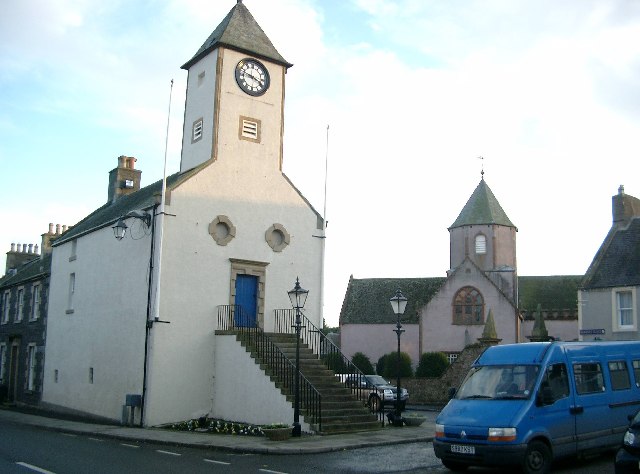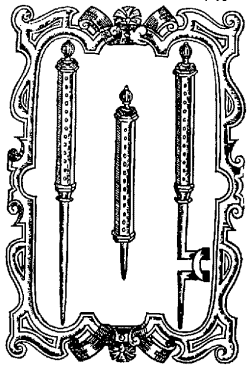|
Margaret Dunholm
Margaret Dunholm was a Scottish woman from Burncastle near Lauder who was accused of witchcraft and executed in 1649. Her surname was also written as "Denholm, "Dinham" and "Dolmoune". She was accused during the Great Scottish witch hunt of 1649–50 The great Scottish witch hunt of 1649–50 was a series of witch trials in Scotland. It is one of five major hunts identified in early modern Scotland and it probably saw the most executions in a single year. The trials occurred in a period of ec .... She was accused by Isobel Thompson from Stow, who was said to be a witch with a male accomplice. John Kinkaid, a witch finder from Tranent who pricked the accused with a bodkin was paid £6 for "brodding" Margaret Dunholm, with £4 expenses for wine and food. The bodkin used was also called a "brod". A record of the expenses of her trial and execution was first printed in 1797. Two barrels of tar were used to build the fire. The execution was supervised by the hangman of Haddi ... [...More Info...] [...Related Items...] OR: [Wikipedia] [Google] [Baidu] |
Lauder
The former Royal Burgh of Lauder (, gd, Labhdar) is a town in the Scottish Borders in the Shires of Scotland, historic county of Berwickshire. On the Southern Upland Way, the burgh lies southeast of Edinburgh, on the western edge of the Lammermuir Hills. Etymology Although Lauder sits in the valley of Leader Water, William J. Watson, Watson notes that the names Lauder and Leader appear to be unconnected. In the earliest sources Lauder appears as ''Lawedder'' and ''Loweder''. The name may be derived from the Common Brittonic, Brittonic ''lǭwadr'', meaning "washing or bathing place" (Breton language, Breton ''laouer''). Or else, Lauder may be named from a word related to Middle Welsh ''llawedrawr'', "a heap of ruins". Medieval history Below Lauder are the lands of Kedslie which were bounded on the west by a road called "Malcolm's rode", and it is thought this formed part of the Roman road known as Dere Street, which passed through Lauder. Hardie suggests that it had been rec ... [...More Info...] [...Related Items...] OR: [Wikipedia] [Google] [Baidu] |
Great Scottish Witch Hunt Of 1649–50
The great Scottish witch hunt of 1649–50 was a series of witch trials in Scotland. It is one of five major hunts identified in early modern Scotland and it probably saw the most executions in a single year. The trials occurred in a period of economic, political and religious unrest. Political and religious turmoil was caused by defeat for the Scottish army in the Second English Civil War and the rise to power of the radical Kirk party, who attempted to create a "godly society", rooting out witches and other offenders. They passed a new Witchcraft Act in 1649 and encouraged local presbyteries to seek out witches. The intense period of witch hunting began in 1649 and continued into 1650, being largely confined to the Lowlands, particularly Lothian and Fife, but spilled over into northern England, where Scottish witch prickers were active. The period of rule by the Kirk party ended when Oliver Cromwell led an army across the border in July 1650. Some 612 records of accusations of w ... [...More Info...] [...Related Items...] OR: [Wikipedia] [Google] [Baidu] |
Stow Of Wedale
Stow of Wedale, or more often Stow, is a village in the Scottish Borders area of Scotland (historically Midlothian), north of Galashiels. In the 2011 Census the population was 718. It is served by Stow railway station. The name The name Stow is an Old English word '' stōw'' meaning 'holy place' or 'meeting place', whilst Wedale is probably derived from the words '' wēoh'' (or ''wīg'') meaning 'shrine' and '' dæl'' meaning 'valley'. History There has been a church at Stow since the 7th century, but the earliest example still visible today was built in the late 15th century on the site of the Church of St Mary which was consecrated on 3 November 1242. The church used today, St Mary of Wedale, was built in 1876 and features a 140-foot-high clock tower. Our Lady's Well is situated south of the village and was rebuilt in 2000. A rare example of a packhorse bridge, built in the 1650s, can be found in Stow. Stow of Wedale Town Hall was completed in 1857. In 1870, James Thin p ... [...More Info...] [...Related Items...] OR: [Wikipedia] [Google] [Baidu] |
John Kincaid (witch-pricker)
John Kincaid (fl. 1649-1662) was a Scottish witch-pricker and a key figure in the Great Scottish Witch Hunts of 1649-50 and 1661-62. Biography John Kincaid was based primarily in Tranent and earned his living from 'unmasking' witches in the localities of Tranent, Dalkeith, Dirleton, Forfar, and Kinross. His dates of birth and death are unknown and little is known of his personal life. He is first mentioned in records in June 1649, when he acted as pricker in the witchcraft trials of Patrick Watson and his wife Menie Haliburton in the Great Hall at Dirleton Castle, near North Berwick.It can be deduced from the records that his professional status was already established by then. John Kinkaid pricked the accused with a bodkin and was paid £6 for "brodding" Margaret Dunholm, with £4 expenses for wine and food. The bodkin used was also called a "brod". He is regularly identified as a witch-pricker in court documents from 1649 to 1662, when his career came to a s ... [...More Info...] [...Related Items...] OR: [Wikipedia] [Google] [Baidu] |
Tranent
Tranent is a town in East Lothian (formerly Haddingtonshire), in the south-east of Scotland. The town lies 6 miles from the boundary of Edinburgh, and 9.1 miles from the city centre. It lies beside the A1 road, the A1 runs through the parish splitting the parish from its associated villages and hamlets namely Meadowmill and the port of the parish Cockenzie. The original main post road ran straight through the town until the new A1 was built. Built on a gentle slope, about above sea level it is one of the oldest towns in East Lothian. The population of the town is approximately 12,140, an increase of over 4,000 since 2001. Tranent was formerly a major mining town, but now serves as a commuter town for Edinburgh. History The name is thought to be of Brythonic origin, possibly containing the elements ''Tre'' and ''Nant'', meaning town over the stream Travernant. Tranent was once an important mining town, and coal was first worked there in the thirteenth century by the monks ... [...More Info...] [...Related Items...] OR: [Wikipedia] [Google] [Baidu] |
Pricking
During the height of the witch trials of the 16th and 17th centuries, common belief held that a witch could be discovered through the process of pricking their skin with needles, pins and bodkins – daggerlike instruments for drawing ribbons through hems or punching holes in cloth. This practice derived from the belief that all witches and sorcerers bore a witch's mark that would not feel pain or bleed when pricked. The mark alone was not enough to convict a person, but did add to the evidence. Pricking was common practice throughout Europe. Professional witch finders earned a good living from unmasking witches, travelling from town to town to perform their services. Hollow wooden handles and retractable points have been saved from these finders, which would give the appearance of an accused witch's flesh being penetrated to the hilt without mark, blood, or pain. Other specially designed needles have been found with a sharp end and a blunt end. Through sleight of hand ... [...More Info...] [...Related Items...] OR: [Wikipedia] [Google] [Baidu] |
Haddington, East Lothian
The Royal Burgh of Haddington ( sco, Haidintoun, gd, Baile Adainn) is a town in East Lothian, Scotland. It is the main administrative, cultural and geographical centre for East Lothian. It lies about east of Edinburgh. The name Haddington is Anglo-Saxon, dating from the sixth or seventh century AD when the area was incorporated into the kingdom of Bernicia. The town, like the rest of the Lothian region, was ceded by King Edgar of England and became part of Scotland in the tenth century. Haddington received Burgh status, one of the earliest to do so, during the reign of David I (1124–1153), giving it trading rights which encouraged its growth into a market town. Today, Haddington is a small town with a population of fewer than 10,000 people. But during the High Middle Ages it was the fourth-biggest town in Scotland (after Aberdeen, Roxburgh and Edinburgh). In the middle of the town is the Haddington Town House, completed in 1745 based on a plan by William Adam. When firs ... [...More Info...] [...Related Items...] OR: [Wikipedia] [Google] [Baidu] |
1649 Deaths
Events January–March * January 4 – In England, the Rump Parliament passes an ordinance to set up a High Court of Justice, to try Charles I for high treason. * January 17 – The Second Ormonde Peace concludes an alliance between the Irish Royalists and the Irish Confederates during the War of the Three Kingdoms. Later in the year the alliance is decisively defeated during the Cromwellian conquest of Ireland. * January 20 – Charles I of England goes on trial, for treason and other "high crimes". * January 27 – King Charles I of England, Scotland and Ireland is found guilty of high treason in a public session. He is beheaded three days later, outside the Banquet Hall in the Palace of Whitehall, London. * January 29 – Serfdom in Russia begins legally as the Sobornoye Ulozheniye (, "Code of Law") is signed by members of the Zemsky Sobor, the parliament of the estates of the realm in the Tsardom of Russia. Slaves and free peasants are con ... [...More Info...] [...Related Items...] OR: [Wikipedia] [Google] [Baidu] |
17th-century Scottish Women
The 17th century lasted from January 1, 1601 ( MDCI), to December 31, 1700 ( MDCC). It falls into the early modern period of Europe and in that continent (whose impact on the world was increasing) was characterized by the Baroque cultural movement, the latter part of the Spanish Golden Age, the Dutch Golden Age, the French ''Grand Siècle'' dominated by Louis XIV, the Scientific Revolution, the world's first public company and megacorporation known as the Dutch East India Company, and according to some historians, the General Crisis. From the mid-17th century, European politics were increasingly dominated by the Kingdom of France of Louis XIV, where royal power was solidified domestically in the civil war of the Fronde. The semi-feudal territorial French nobility was weakened and subjugated to the power of an absolute monarchy through the reinvention of the Palace of Versailles from a hunting lodge to a gilded prison, in which a greatly expanded royal court could be more easily k ... [...More Info...] [...Related Items...] OR: [Wikipedia] [Google] [Baidu] |
Executed Scottish Women
Capital punishment, also known as the death penalty, is the state-sanctioned practice of deliberately killing a person as a punishment for an actual or supposed crime, usually following an authorized, rule-governed process to conclude that the person is responsible for violating norms that warrant said punishment. The sentence ordering that an offender is to be punished in such a manner is known as a death sentence, and the act of carrying out the sentence is known as an execution. A prisoner who has been sentenced to death and awaits execution is ''condemned'' and is commonly referred to as being "on death row". Crimes that are punishable by death are known as ''capital crimes'', ''capital offences'', or ''capital felonies'', and vary depending on the jurisdiction, but commonly include serious crimes against the person, such as murder, mass murder, aggravated cases of rape (often including child sexual abuse), terrorism, aircraft hijacking, war crimes, crimes against ... [...More Info...] [...Related Items...] OR: [Wikipedia] [Google] [Baidu] |






